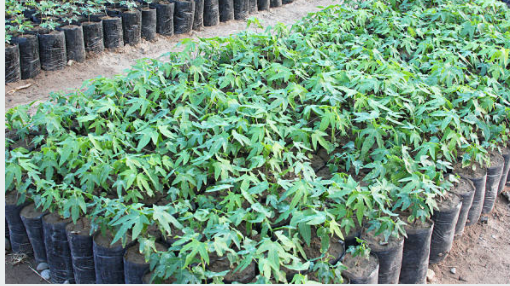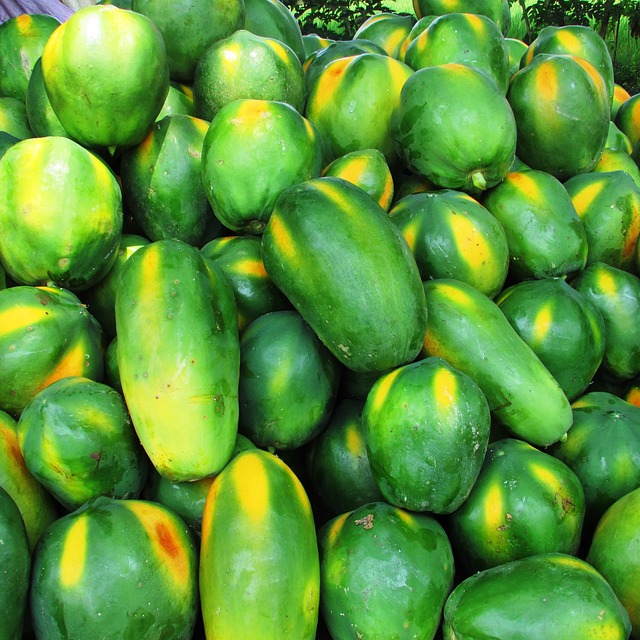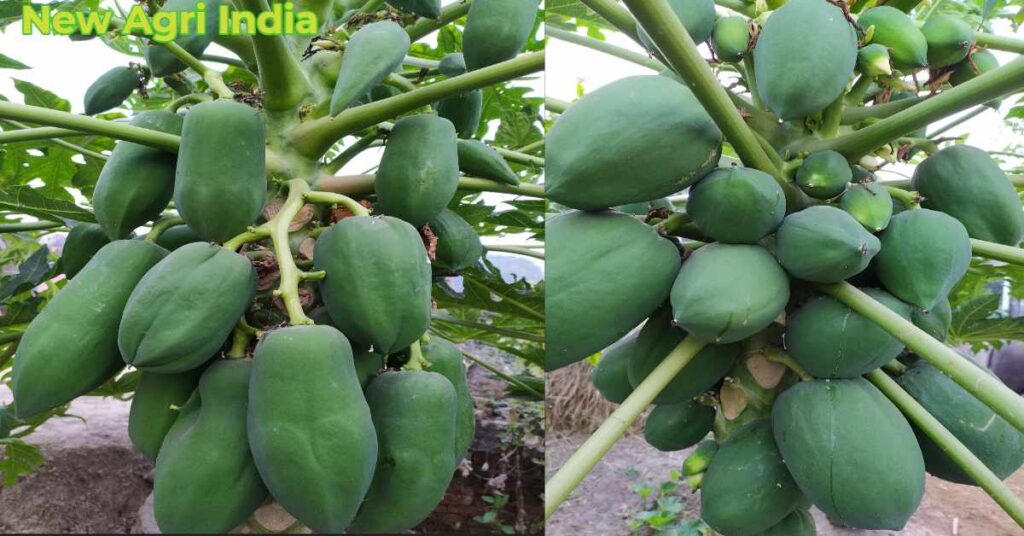An introduction to papaya farming
Nowadays, In most parts of the country, the area of papaya farming is increasing continuously from the home garden to the orchards. Because papaya is a multi-useful fruit. It is a nutritious, very healthy and short period ripening fruit.
Papaya is an ideal fruit for the home garden. Apart from this, it can be grown intermittently in the orchards of large plants like mango. Therefore, the popularity of papaya farming is increasing day by day.
Papaya is used in both ripe and raw forms. Papaya is a good source of carbohydrates, minerals, and vitamins A, B and C. A substance called papain is extracted from the milk of papaya fruits. Papain is used for meat smelting, wool shrinking and other industrial purposes.
Climate for papaya farming
Papaya is mainly a tropical fruit. But in areas with sub-tropical climate where there is no fear of frost, papaya can be cultivated. The optimum temperature for papaya farming is between 22-26°C but should not be less than 10°C. Papaya can also be grown well in places where the temperature ranges from 38°C to 43°C in the summer season.
Extreme cold and frost are the enemies of papaya as it has a bad effect on both the plant and the fruit. For the successful production of papaya, comparatively high temperature, low humidity and sufficient moisture are required.
Soil for papaya farming
Light and fertile sandy loam or loamy soil, where there are good facilities for irrigation and drainage, is best for papaya farming.
Medium black and alluvial soil are also good for its cultivation. The pH value of the soil should be between 6.5 to 7.5.
Improved varieties for papaya farming
To get a good yield from papaya farming, it is very necessary to use of improved varieties. In the absence of improved varieties, even with proper care and use of manure and fertilizer and water, good yield can not be obtained.
Many improved varieties of papaya are grown in different parts of the country, some of the important varieties are as follows:
Red Lady 786
It is a very popular hybrid variety of papaya. The storage capacity of this variety is high as compared to other varieties. It is a high-yielding variety.
Pusa Dwarf
Plants of this variety are dwarf, in which fruits start growing only at a height of 25-30 cm. The weight of one fruit is about 1-1.5 kg.
Pusa Giant
Plants of this variety are tall, in which fruits start growing at a height of 50-75 cm from the ground. Its fruits are of large size, weighing about 2-3 kg.
Pusa Delicious
Fruits start growing on plants of this variety at a height of 40-50 cm from the ground. The fruits of this variety are of medium size weighing about 1.5-2.0 kg. The storage capacity of fruits of this variety is good.
Coorg Honey Dew
Fruits of this variety are medium sized with light stripes and oval shaped.
Washington
It is a tall growing variety. It is a tall growing variety, the nodes of its stem and the stalk of the leaves are purple in color. The flowers are yellow and the fruits are oval. The fruits start growing in the plants from a height of 1.5 meters.
Arka Surya
This hybrid variety of papaya has been developed from Indian Institute of Horticultural Research Bengaluru. Plants of this variety are of gynodioecious nature in which there are no male plants, so only one plant is planted in the pit.
Fruits are of medium size weighing about 600-800 g with a small fruit cavity. The fruits become uniformly yellow when ripe, the pulp is about 3-3.5 cm thick, dark red in color. The yield per plant is about 55-65 kg.
Apart from the above varieties, other varieties of papaya are Coimbatore-1, Coimbatore-2, Pusa Nanha, Pusa Papaya-1, Pusa Majesty, Arka Prabhath and Ranchi etc.
Preparation of Papaya nursery
Papaya plants are mainly propagated from seeds. To prepare papaya nursery, beds are made 10-15 cm high and 1.5 meters wide. In these beds, decomposed Farm Yard Manure should be mixed in sufficient amount. Seeds should be sown in the beds two months before transplanting.
Before sowing, seeds should be treated with Thiram (2 gm/per kg of seed). Seeds should be sown at a depth of 1.5 cm by making rows at a distance of 15 cm in the beds. 400-500 grams of seed is sufficient for planting one hectare of papaya.
After sowing the seeds should be covered with a mixture of compost and soil. After this, cover the beds with dry grass and keep watering as needed. The seeds start germinating in about 10 days. When germination starts, dry grass should be removed from the beds.
When the plants become 8-10 cm tall, then plant them in 500 g capacity polythene bags by filling mixture of soil and manure. Holes should be made for aeration in polythene bags. Irrigation should be done after planting the saplings in polythene bags.

After keeping these polythene bags in the shade for 3-4 days, keep them in the sun. Keep irrigating as needed. After about a month, the plants can be planted in the field.
Papaya plantation time
Papaya plants can be planted 3 times in a year:
- Start of rainy season – June-July
- End of rainy season – September-October
- Spring season – February-March
It is best to transplant papaya in June-July.
Papaya plantation method
Before planting the seedlings, the field should be well prepared and leveled so that water does not accumulate at one place. Then 50*50*50 cm size pits should be dug at a distance of 1.5*1.5 meters. In each pit, 20 kg of decomposed Farm Yard Manure and 1.25 kg bone powder should be filled by mixing it with soil. For tall growing varieties, spacing of 1.8*1.8 meters is kept in the rows of pits.
When the plants become 20-25 cm tall, 2 plants are planted in each pit at a distance of 30 cm. If possible, plants should be planted in the evening. Irrigation should be done after transplanting the seedlings.
Manure and Fertilizer for papaya
Papaya starts bearing fruit early so it needs more fertile land. Therefore, to get good yield, 200 grams of nitrogen, 250 grams of phosphorus and 500 grams of potash are required per tree per year. Apart from this, 20-25 kg Farm Yard Manure, 1 kg bone powder and 1 kg neem cake is required per plant per year.
The entire quantity of manure should be applied in three equal parts in the months of March-April, July-August, October-November.
Irrigation in Papaya
In the climate of South India, water should be given at an interval of 9-10 days in winter and 6-7 days in summer. In northern India, irrigation should be done twice a week from April to June month and in winter, it should be done at an interval of 15 days.
It is necessary to take care that the water should not touch the stem of the plant, otherwise there is a possibility of rotting disease in the plant. Therefore, the soil should be kept high (Earthing Up) around the base of plants.
Intercrops and weeding
Intercropping of ginger, peas and fenugreek can be done in a papaya garden. To keep the papaya farm neat and clean, after each irrigation, light weeding should be done around the trees.
To protect papaya trees from frost, smoke should be done from time to time and other possible measures should also be taken.
Removal of male plants
Flowering starts about 6 months after planting. After flowering, leaving only 10% of the male plants, the rest of the male plants should be removed and replaced by new female plants because 10% of male plants are sufficient for pollination in the papaya garden.
Removal of excess fruit
The size of the fruit becomes very small due to the excess of fruits on the plants. Therefore, in order to get big and shapely fruits, small unnecessary fruits should be plucked. A plant gives an average of 50 fruits per year.
Pests and diseases in papaya farming
Red spider mite (Tetranychus cinnabarinus)
This pest attacks on leaves and fruits. It sucks the juice from the leaves due to which the leaves turn yellow.
Control- For its prevention, spray Cypermethrin 0.15% solution on the affected plants.
Diseases
Stem or Root rot
This disease is caused by a fungus. In this disea2se, the outer peel of the stem turns yellow and starts rotting near the ground level and the root also starts rotting. The leaves dry up and the plant dies.
Control- For the treatment of this disease, good drainage system should be made in the garden and the affected plants should be removed and thrown away. Spraying of plants with 1% Bordeaux mixture or copper oxychloride @ 2 g/Lit of water provides considerable prevention.
Damping off
In this disease, when the plants are in nursery, lesions appear on the stems close to the ground and the plants wilt and die.
Control- To prevent this disease, seed should be treated with Thiram before sowing and seedbed should be treated with 2.5% formaldehyde solution.
Leaf curl and Mosaic
Both of these are viral diseases. In Leaf curl disease, the leaves become small, wrinkled and deformed. In mosaic disease, the leaves of the plants become spotted, yellow and small in size. Green blisters appear on the leaves.
Control- Affected plants should be uprooted and burnt or buried in the ground. Spraying of 0.15% cypermethrin solution on plants at an interval of 10-12 days should be done to kill the virus carrier insects. Do not grow pumpkin-class vegetables as an intercrop.
Harvesting and Yield of papaya
Papaya fruits are harvested when the fruits reach full size and yellowish color starts appearing on the fruits. On ripening, the fruits of some varieties turn yellow, while the fruits of some varieties remain green. When the latex stops turning milky and becomes watery, the fruits are suitable for harvesting.
It is beneficial to ripen fruits artificially. For this, keep the fruits in sacks or wrapped in paper and keep them in the house, in this way the fruits ripen in 3-4 days.

The yield of papaya depends on the variety, soil, climate, age of the plant and management of the orchard. Up to 25-100 fruits are obtained from one papaya plant. The weight of one fruit varies from 500 g to 3 kg. Once papaya is planted, three profitable crops can be obtained. A yield of 75-100 tonnes per hectare can be obtained from a papaya orchard in one crop year.
Note: Any recommendations regarding the use of chemicals are for informational purposes only. Before using any type of chemical for pest and disease control, consult the nearest agriculture shop or a local agricultural consultant.
How helpful was this post for you, you can tell me in the comment box and you can also give us your advice, your comment and advice are very important for us.
Thank you..!

Very useful for beginners like me. How is calina variety?
Thank you
Thank you bro
Hi Jitendra
I am Planning to start Papaya farming 1 acre Land.
Could you please send me the details and plants location where I can get this.
Thanks
Shahid Sisodiya
9650046543
Dear
Mr. sisodiya, I do not sell plants.
I would suggest you that search in your nearby area.
Well, lots of people are selling plants and they are advertising in my facebook group naming “new agriculture India”.
Hi Jitendra,
I am Planning to start Papaya farming 1 acre Land.
Could you please suggest me which papaya plant bread should I cultivate form more profit and please send me more details
Thanks
Manish Sharma
Hi dear
Please share Red Lady seed availability
Kind regards
Shaikh 9638308570
Very informative and useful for the first time papaya growers like me. I am a organic farmer so Can you also mention the organic substitutes for the mentioned chemical fertilizers and pesticides
Really very useful information to farmers having interest in cultivation of Papaya. I have gone through this process planted first time Taiwan Red lady 786 variety and gererated income of Rs. 2.50 lacs in two years in half acre plot.
There are nearly 50 nos Mango plants and papaya cultivated in open spaces.
It was amazing experience.
Could you please provide me the medecine, fertilizer schedule for papaya.thank you.
i have 1/2 acres of land in gurgaon and i want to grow pappaya. can you help in selection, plantation and then selling the produce. My mobile no is 9958894141
Dear Sir,
I can not help in selling produce, because I only provide agriculture-related knowledge.